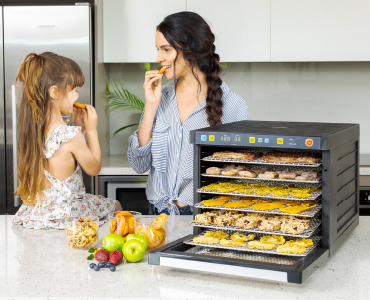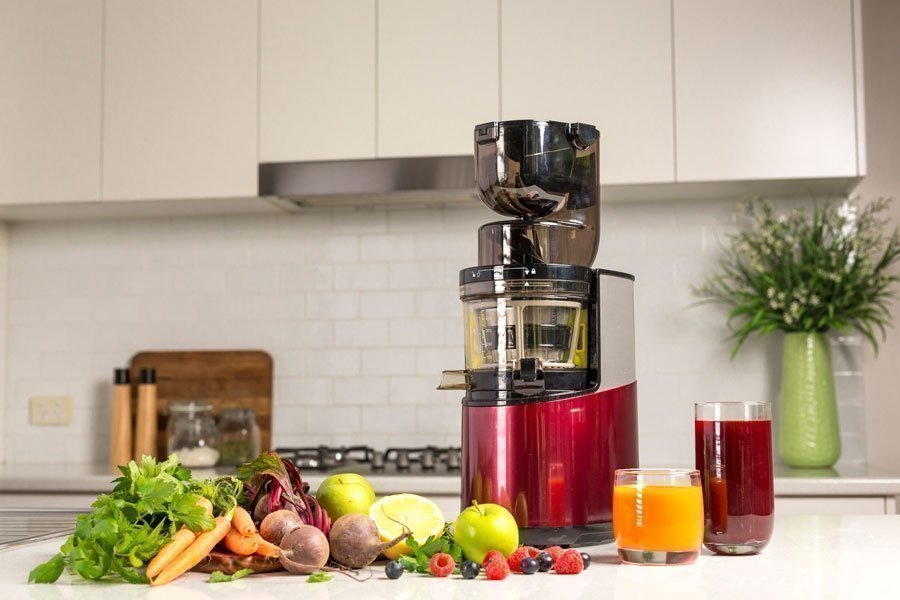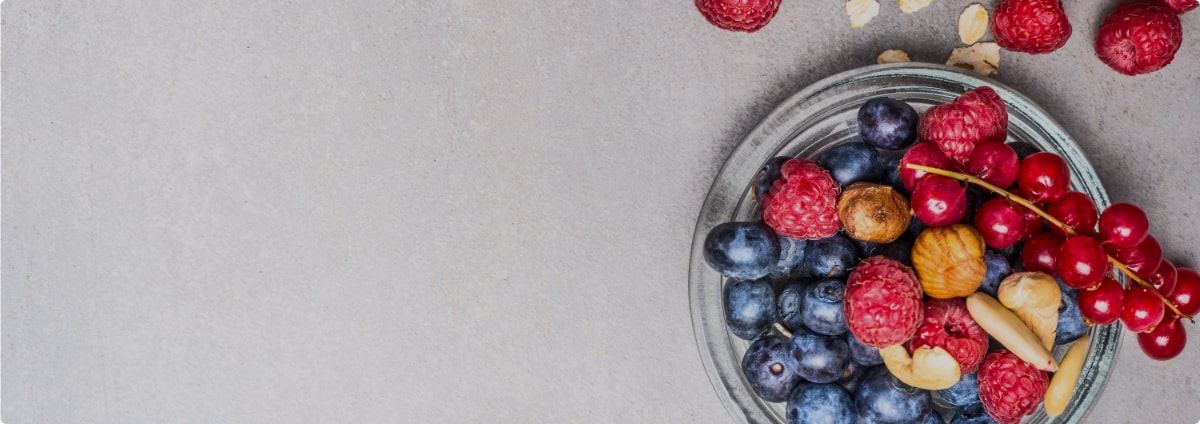Vitality 4 Life uses cookies to provide and improve our services, if you continue browsing, we consider that you accept its use. For more information, please see our privacy page.
-
22,April,2021Read More
What are food dehydrators?
Food dehydrators are a great way to reduce your cost of food, increase your nutritional intake and speed up your cooking.
In the past our ancestors relied on the sun to dry out food, but these days it is a process where moisture is removed from foods by circulating air at a very low temperature in an oven-like device including two main designs: stacked shelves and pull out shelves.
In this article we will cover the benefits of using food dehydration plus some great tips on deciding the best machine for your home or business, all backed by Vitality 4 Life’s 30 day return policy, 24/7 customer support and extended warranties.
What are the main benefits of dehydrating food?
There are many benefits to dehydrating your food and getting a food hydrator machine.
Increases your fibre intake
Studies have shown that food dehydration helps to increase the fibre intake of fruits and vegetables. Fibre is an essential nutrient for gut health, digestion and overall wellbeing and many people do not get enough daily fibre according to Australian and American departments of health.
It is recommended you consume at least 25 - 30 grams of fibre per day. One example of fibre increasing in a fruit dehydrator is apricots. When apricots are dehydrated fresh apricots have 3.1 grams of fibre while dried apricots contain 6.5 grams of fibre.
Increased energy and absorption
Food dehydrators can help with concentrating calories in your snacks, providing a longer, sustained energy release for your body.
This is helpful for people who go outdoors on long walks, hikes or camping for example, where sugars are important for long periods of activity without the access to refrigeration.
Increased nutritional content
It has also been shown that food dryer machines i
-
Read More
Dried meat has been popular for thousands of years and it's not hard to see why. It's delicious, virtually fat free, a great source of protein and best of all homemade jerky doesn't have the addition of preservatives or chemical additives so you can be sure that you are eating healthy whole food.
There is no science behind making any meat jerky, all you have to do is know what flavours you like, use the freshest of fresh meat and you can be assured of a yummy snack.
One of the things we get asked for most frequently is how to make meat jerky. Here is a selection of recipes, tried and tested and completely delicious, which you can create using your own food dehydrator!
Homemade Jerky: The Basics

- Select only the leanest cuts of meat as fat can affect the drying times and will become rancid very quickly meaning that your jerky will not last as long
- Be sure to allow adequate space in between slices to allow for air circulation
- Partially frozen meat is much easier to slice into thin strips. For a chewy jerky cut strips along the grain, for a more tender jerky cut against the grain
- The thicker you slice your meat the longer it will take to dry
- Keep your strips as uniform in size as possible to ensure even drying
- Be sure to let jerky cool completely before storing as any moisture will cause the jerky to spoil. Always store in an airtight container.
- Use times as a guide only, if you prefer a crispy jerky dry for longer.
- You may need to use a fine mesh sheet on top of your dehydrating trays depending on how big the holes are in the trays
- Experiment with different
-
18,July,2019Read More
No one else will think of this one, a truly unique gift for pet lovers... make your own healthy dog treats.
We all know someone who loves their dog more than people. If you want to find a unique gift for pet lovers that no one else will think of start here with our food dehydrators. Sound boring? It definitely won't be for them when they are making their own healthy dog treats. Or how about buying one for yourself and giving the treats as a gift! Either way they will love it.
Pet lovers love to know exactly what their doggy treats are made of. With unhealthy treats everywhere at the moment and overseas companies taking over some of our own brands what is in the doggy bag may not be such a treat.

Healthy Bite
There are many news items at the moment suggesting that here are some dangerous dog treats on the market that should be avoided at all costs. Some that can result in serious injury and even death. Beef jerky in particular. If you choose a unique gift for pet lovers from our a food dehydrator range they can make delicious and healthy beef jerky and other treats for their furry best friend at home in their own kitchen.
Click here from some delicious recipes for people and pups.

-
20,October,2016Read More
Trying to maintain a healthy diet, but still love to snack on sweet things? Homemade Fruit Leather may be a great addition to your raw food diet. Not only are these delicious home-made 'roll-ups' a healthy alternative to commercial snack foods, but they taste fantastic! Perfect for a mid-afternoon snack to tackle those sugar cravings and the kid's lunch boxes. Plus, they're so quick and easy to make!

A fruit leather or fruit roll up is basically blended fruit which is poured out into a thin consistency and dried out. You can think of it like making a smoothie and drying it out! Fruit leathers generally consist of blended fruit however other ingredients can be added to enhance flavours and make unique combinations including yoghurt - to give the roll ups a creamy texture - or spices such as cinnamon work really well too.The best tools to have when making fruit roll ups are a good quality blender and a food dehydrator. A blender will allow you to chop and blend the ingredients together in just a few moments and give you a beautiful smooth texture. Also, by having a blender there is no need to stew the fruits over a stove prior to straining or pureeing. You simply put the raw ingredients into a blender and the work is done for you. The fruits then retain their living enzymes and nutrients as they have not been exposed to heat and stewed for hours.
The food dehydrator will replace an oven in the fruit leather making process. A food dehydrator usually costs about 4 cents an hour to run compared to an oven which costs around 60 cents an hour to run! This adds up when the average time taken to make a fruit leather is 8 hours!
You can find our favourite blender
-
09,March,2015Read More
How to Sprout Whole Grains and Make Sprouted Flour
Making your own sprouted flour is definitely a labor of love, however the end result and the nutritional value makes it absolutely worth it!
The traditional way to prepare grains back in the day was to soak them until they had begun to form little sprouts, this was done for easier digestability and to increase the essential vitamins like vitamins B and C. It was also done to reduce the bad phytic acid which can actually decrease the body’s ability to absorb iron, magnesium, zinc, copper and calcium. All vital nutrients that our bodies need! This method of grain preparation can even help break down the gluten in the wheat berry making it possible for people with a gluten intolerance to enjoy grains again!
Sprouted grain flour has seen a resurgence in popularity of late and is fast becoming popular in many home kitchens and cafes. Many healthy home enthusiasts are returning to these traditional preparation methods. It can be made it in bulk and stored in airtight containers in your cupboard or you can even freeze it to use in sweet treats like sprouted grain cookies, or sprouted bread. There is nothing quite like knowing you have made your own healthy flour!
Sprouting the grains does take a bit of time, but it is easy and can be done in bulk so that you only have to do it every month or so depending on how much sprouted flour you and your family use. You can sprout any grain, provided you’re working from the whole grain berry, not a rolled, flaked or otherwise damaged grain. Wheat, spelt, oats and barley will all work very well for sprouting.
You will need to begin the dehydrating process not long after the root tip appears, if left to sprout for too long you will run the risk of “malting” the grains which is not ideal. This can cause the flour to become overly sweet and it can also cause an undercooked sticky texture when used for bread and cakes.
You
-
30,April,2013Read More
We have all heard 'breakfast is the most important meal of the day', but why? Having breakfast doesn't only provides key 'fuel' for the body and brain, but also kick-starts your metabolism for the day ahead!
If you are beginning a Raw Food Diet or even beginning to experiment with Raw Food Recipes, you may be wondering what to eat as a Raw Breakfast. It is not just smoothies and fruit which are easily made on the go, try these quick and easy Raw Breakfast Recipes, packed with everything you need to start the day in the right way!
Vitality 4 Life's Raw Breakfast Recipes:
Raw Banana Pancakes
Serving for 1
Ingredients:- 1 banana
- 2 tablespoons coconut meal or dried coconut flakes
- Cinnamon
Mash the banana with a fork in a bowl until smooth. Add the coconut meal and some cinnamon, mix well. Flatten the banana/coconut dough and make small pancakes of them. Put the pancakes in a Food Dehydrator or in the oven until they are crispy on the outside. They shouldn't be completely dry but just on the outsides. It is better to prepare them the night before so you only have to heat them up before breakfast time!
Garnish with your favourite fresh fruits, syrups or agave syrup.
Protein Packed Chia Gel Cereal with Seasonal Fruit
Serving for 1- 1 tsp chia seeds
- Dash of cinnamon
- Ground flax
- Seasonal fruits such as apple, mixed berries and grapefruit
Place 1 teaspoon of Chia Seed with 8 teaspoons of water.Let it stand and "set" for 30 minutes and a gel will form. Chia is almost tasteless and practically anything can be added to make flavor. It is also a super protein seed and provides you with maximum energy. Add seasonal fruits for a delicious protein-rich start to the day!
Super "Get-Up & Go " Green Smoothie:
- 1 handful of raw nuts (almonds, cashews)
- 1/2
-
Read More
Kale Chips
As well as being high in vitamins A, C & K, kale helps to fight heart disease, cancer, mental illness and high blood pressure. These kale chips are a great healthy snack to fight those cravings.
You can make this healthy snack in a food dehydrator or an oven.
Ingredients:
- 1 head kale, washed and dried thoroughly
- 2 tbsp extra virgin olive oil or flax seed oil
- Sea salt for light seasoning
Procedure for oven:
- Preheat oven to 120ºC
- Remove the ‘ribs’ from the kale and cut into 2 inch pieces
- Toss with olive oil and salt
- Lay on a baking tray and bake in the oven for 20mins until crisp, making sure to turn half way through
- Serve hot or allow to cool and eat as a healthy snack or add to salads
Procedure for food dehydrator:
- 1. Chop Kale into 2 inch pieces. Remember they will shrink in size after they have been dehydrated so make them bigger than bite size
- Drizzle with flax seed oil and sprinkle with sea salt
- Leave for around 30mins to absorb the flavours
- Spread pieces out onto your food dehydrator tray
- Set your dehydrator to 52ºC and leave kale chips in for around 8 hours
- Chips will be ready when they are crispy – don’t be tempted to take them out too early!
These chips will keep for around 2 years if stored correctly. We recommend the Bio Chef Food Dehydrator for best results
Banana Chips
Slightly brown-flecked bananas will have the sweetest, most concentrated flavour when dried.
- Peel the bananas. Slice bananas into 1/4-inch or 3/8-inch chips.
- Dip each banana slice into the lemon juice. This lessens browning of the banana chips and adds a bit of vitamin C back into the banana.
- Shake off the extra lemon juice and lay the


















